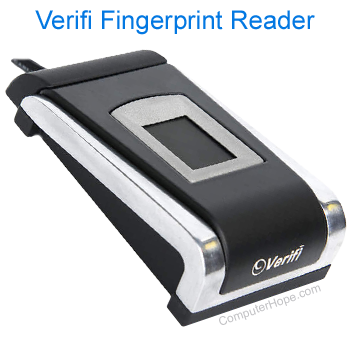Biometrics

With computers and security, biometrics is the identification of a person by the measurement of their biological features. For example, users identifying themselves to a computer or building by their fingerprint or voice is considered a biometrics identification. Compared to a password, this type of system is more difficult to fake since it is unique to the person. Other common methods of a biometrics scan are a person's face, hand, iris, and retina.
Types of biometric devices
Below is a listing of all known biometric devices used to input biometric data into a computer. This data is known as a biometric identifier, a physical, chemical, or behavioral characteristic.
- Face scanner - Biometric face scanners identify a person by taking measurements of a person's face. For example, the distance between the person's chin, eyes (interpupillary distance), nose, and mouth. These scanners can be very secure, assuming they're smart enough to distinguish between a picture of a person and a real person. See our facial recognition page for further information on this term.
- Hand scanner - Like your fingerprint, the palm of your hand is also unique to you. A biometric hand scanner or hand geometry system identifies the person by the palm of their hand.
- Finger scanner - Like the picture shown on this page, a biometric finger scanner identifies the person by their fingerprint. These are a secure method of identifying a person. However, cheap and less sophisticated fingerprint scanners can be duped in several ways. For example, in the show Myth Busters, they were able to fake a fingerprint using a Gummy Bear candy treat.
- Retina scanner or iris scanner - A biometric retina or iris scanner identifies a person by scanning the iris or retina of their eyes. These scanners are a more secure biometric authentication schemes because there's no known way to duplicate the retina or iris.
- Signature verification system - System that recognizes the shape of your handwritten signature as a form of identification.
- Vein recognition - A biometric scan of a person's veins in the user's finger or palm. See our vein recognition page for further information.
- Voice scanner - Finally, a voice analysis scanner or voice verification system mathematically break down a person's voice to identify them. These scanners help improve security, but some less sophisticated scanners can be bypassed using a tape recording.
ACS, Authentication, AVR, Face ID, Fingerprint, Input device, Possessed object, Security terms, Touch ID, Vein recognition
